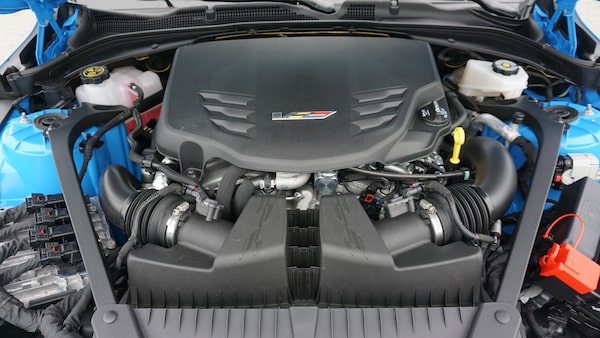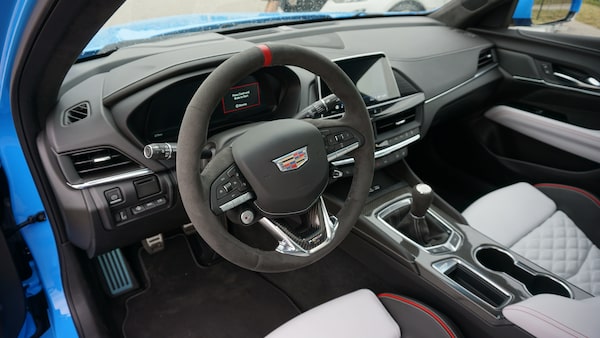
The 2022 Cadillac CT5-V Blackwing.Photography by JEREMY SINEK/THE GLOBE AND MAIL
In case you didn’t get that memo yet, I’ll send it again: some of the finest sports sedans ever to prowl this planet have been Cadillacs. Yes, Cadillacs.
This improbable state of affairs emerged in 2004 when Cadillac slotted a Corvette V8 into the CTS sedan and called it the CTS-V. And the sedan achieved near-perfection in the CTS-V’s 2009-2014 second generation, in which the V8 acquired a supercharger but was still (unlike the subsequent Gen 3 CTS-V) available with a six-speed manual gearbox.
Meanwhile, Cadillac also birthed the 2013 ATS compact sedan. The all-new baby Cadillac out-BMW’d the BMW 3 Series right out the box, and sealed the deal when it acquired its own V suffix to go with a 464-horsepower twin-turbo 3.6-litre V6 and, what Car and Driver called, a “superlative chassis.”
Fast forward to 2020, and the CT4 and CT5 replace the ATS and CTS respectively. These, too, can be had with a V tag, but the label no longer means the same; today’s V indicates a new intermediate level of sportiness between the base models and the newly arrived top-of-the-line Blackwings. Like Audi, BMW and Mercedes, Cadillac now offers both light and full-strength versions of its performance cars.

The CT5-V Blackwing’s supercharged 6.2-litre V8 pounds out 668 horsepower and 659 lb-ft of torque.
We’ve had our first taste of both Blackwings, and it tells you a lot about Cadillac’s confidence that the drive didn’t just include a race-track, it was all race-track — both the driver development track, and the daunting Grand Prix circuit itself, at Canadian Tire Motorsport Park.
A further declaration of the Blackwings’ built-for-drivers intent: both let you stir your own cogs with a six-speed manual gearbox instead of the alternative automatic, the latter a 10-speed that Cadillac says can shift faster than a Porsche PDK. So far, a remarkable 60 per cent of buyers have chosen the do-it-yourself gearbox, a ringing endorsement of the cars’ credibility among knowledgeable gearheads.
The CT5-V Blackwing’s supercharged 6.2-litre V8 pounds out 668 horsepower and 659 lb-ft of torque, and if that doesn’t sound neck-snapping enough, Cadillac worked hard to minimize the fractions-of-a-second delay between cracking open the throttle and actually feeling the response. By that measure, only a Ferrari 488 engine is in the same league. Claimed maximum speed is 322 kilometres an hour; try that in grandpa’s Fleetwood Brougham.
The smaller Blackwing’s 3.6-litre V6 now makes 472 horsepower (up eight) and the same 445 lb-ft as before.
Among other hardcore performance credentials: the CT5-V’s brakes are sized to handle stops from 322 kilometres an hour fully laden, and carbon-ceramic brakes are an option; both Blackwings have version 4.0 of GM’s ever-brilliant magnetic ride control; the tires are Blackwing-exclusive Michelin Pilot Sport 4S summer rubber, of which Cadillac sedans chief engineer Tony Roma said, “every time we do this, the tires take a huge leap”; and the manual gearbox comes with active rev matching and no-lift shifting.

The entry price for the CT4-V and CT5-V Blackwings is well below alternatives of comparable calibre.
As well, the CT4-V Blackwing is available with carbon-fibre aerodynamic packages that generate 169 pounds of downforce at 290 kilometres an hour. Package 1 comprises such arcane add-ons as front dive planes, underwing strakes, front wheel deflectors and more-aggressive front splitter and rear spoiler. Package 2 adds rocker extensions and a rear diffuser. These pieces work together to achieve actual downforce that presses the car more firmly to the road at speed, whereas most cars would experience de-stabilizing lift.
There are also multiple drive modes, including Track, plus five levels of Performance Traction Management, and if you turn off the stability control, it really is off. There’s “no hidden Angel mode to swoop in and save you,” Roma says.
In parallel with all the track-worthiness, Cadillac says it also worked on refinement. The new-generation dampers soften the ride when you’re not in attack mode, and measures were taken to quiet the workings of the manual gearbox.
Track driving is hardly the best window into refinement, not least because you’re insulated from the soundtrack by a head sock and padded helmet. Still, puttering through the pit lane at 30 kilometres an hour after half a dozen hot laps reveals disarming docility. The stout shifters move with smooth accuracy. Clutch engagement on the manuals is progressive, and pedal effort surprisingly low, even on the one that has to transmit the monstrous torque of the CT5′s big V8.
Ah yes, that V8. Some cars can match or beat its 668 horsepower, but few can equal the “right-now” low-end thrust concocted by a large-displacement V8 (that is, lots of torque even without forced induction) topped by a mechanical supercharger (therefore, no turbo lag). And that colossally effortless performance is all the more seductive when delivered with silky smoothness. The phrase “iron fist in a velvet glove” could have been invented for this engine.

There are multiple drive modes available, including Track.
All of which could be a true handful in a rear-wheel-drive car, were it not for the electronic genius of Performance Traction Management … well, that and our hosts’ strict prohibition on disabling the stability control. In truth, the instructor setting the pace in our lead-follow lapping sessions never “pulled” us hard enough to run out of talent, but it was still hard enough to reveal two truths: both these Cadillac sedans truly feel at home on a race track; and in turn, the calibre of the steering feel and chassis feedback help the driver feel dialled-in and at home in the car.
Despite the glories of its engine, the CT5-V isn’t necessarily the default choice, even if you can afford the extra $13,000. I’m not a particular fan of the CT4′s engine music, and it’s certainly not as fast (though, traction limitations are a great equalizer, and the CT4′s claimed 3.9-second zero-to-96-kilometres-an-hour time for the automatic is closer to the CT5′s 3.4 than you might expect). However, the CT4 is smaller, lighter, has less weight on the front wheels and has the same-size tires front and rear (the CT5 has staggered wheel sizes).
If that sounds to you like a formula for more agility and better cornering balance, you’re right. GM’s own data also show the CT4 grips harder at the limit — 1.04 G-force versus a still-spectacular 1.01.
We can hope that when Cadillac embraces its all-electric future, it will include EVs that are as deeply satisfying to drive as the CT4-V and CT5-V Blackwings. Meanwhile, these ultimate versions of Cadillac’s swan-song gasoline-fuelled sedans represent one heckuva final performance. All at a price of entry well below alternatives of comparable calibre.
Memo to all gearheads: get one while you still can.
2021 Cadillac CT4-V Blackwing and 2021 Cadillac CT5-V Blackwing
Base price:
CT4: $67,298 (manual)/$71,058 (automatic)
CT5: $89,998 (manual)/$93,643 (automatic)
Engine:
CT4: 3.6-litre, twin-turbo V6
CT5: 6.2-litre, supercharged V8
Transmission/drive: Six-speed manual or 10-speed automatic/rear-wheel drive
Fuel consumption: N/A
Alternatives:
CT4: Audi S4/RS5 Sportback, BMW M3, Mercedes-AMG C43 4Matic
CT5: Audi S6, BMW M550i xDrive, Mercedes AMG E53 4Matic
Shopping for a new car? Check out the new Globe Drive Build and Price Tool to see the latest discounts, rebates and rates on new cars, trucks and SUVs. Click here to get your price.